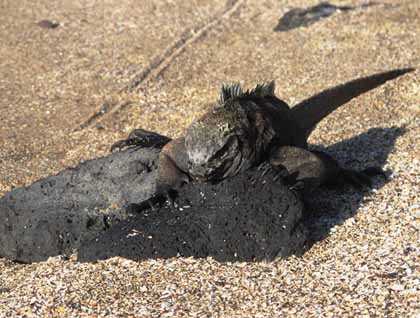We left the western regions, and after night-long navigation we dropped anchor early this morning at Espumilla beach, in the northwestern coast of Santiago. A pre-breakfast outing was on schedule, an optional choice for the early risers. Espumilla is a very important sea turtle nesting beach, and evidence of this in the shape of turtle tracks and nests all along it really surprised us. We walked inland along a trail that took us under a canopy of mature mangrove trees, and also through a forest of ‘palo santo’ or incense trees, the oldest known in the archipelago. Many land bird species inhabit this area, which, being the end of the cool season, is particularly dry; therefore, the behavior of mockingbirds, flycatchers and finches seems to be more dramatic. We returned back on board and our ship continued further north, as our next destination was Buccaneer Cove. This is reputedly a favorite anchorage for buccaneers and pirates, who used it for approximately a span of 200 years. They particularly liked stopping at Santiago, then called James Island, as they were able to find safe anchorages, firewood, abundant tortoises and a freshwater spring. We did not land at Buccaneer Cove, as it is not permitted by the Galapagos National Park Service, but we explored it in various ways. December is a month of changing seasons, and we are shifting from the cool, dry into the wet and rainy one. Therefore, we have experienced northern winds, which have made the coastline of the Galapagos much more dramatic. Some of our guests explored the coastline either by taking a Zodiac ride, or by paddling and kayaking, or by snorkeling. It was a great morning, with plenty of varied adventures!
In the afternoon, we relocated to James Bay. In the center of it we can find remains of a small settlement that lasted just a couple of decades, their economy based on the extraction of salt from a local mine. The business venture collapsed, and the entire island is now part of the natural areas of the National Park. We disembarked at a beautiful beach of black sands named Puerto Egas. There were two choices this afternoon: either enjoy the lovely afternoon sunshine and swim or snorkel at the beach, or take a walk along the trail behind it. Both are great choices, as our guests experienced. The coastline of Puerto Egas looked particularly striking today, as the surf and swells were breaking against the tuff and lava rocks all along. This area is the perfect habitat for various native and endemic creatures: marine iguanas blend perfectly well against the dark background of the basalt, while the Galapagos sea lions find the perfect tidal pools for their young pups. At the far end of the coastal trail, we found a group of natural formations called ‘the grottos’, which are former lava tubes where the roof has collapsed and the sea enters, forming natural pools. This is where the Galapagos fur seals were to be found, one of the endemic species of the islands.
We returned back to the landing beach and on board, while the sun set behind the silhouettes of the shield volcanoes of Isabela Island in the distance. This really felt like a magical day, one never to forget, in the Enchanted Isles.







